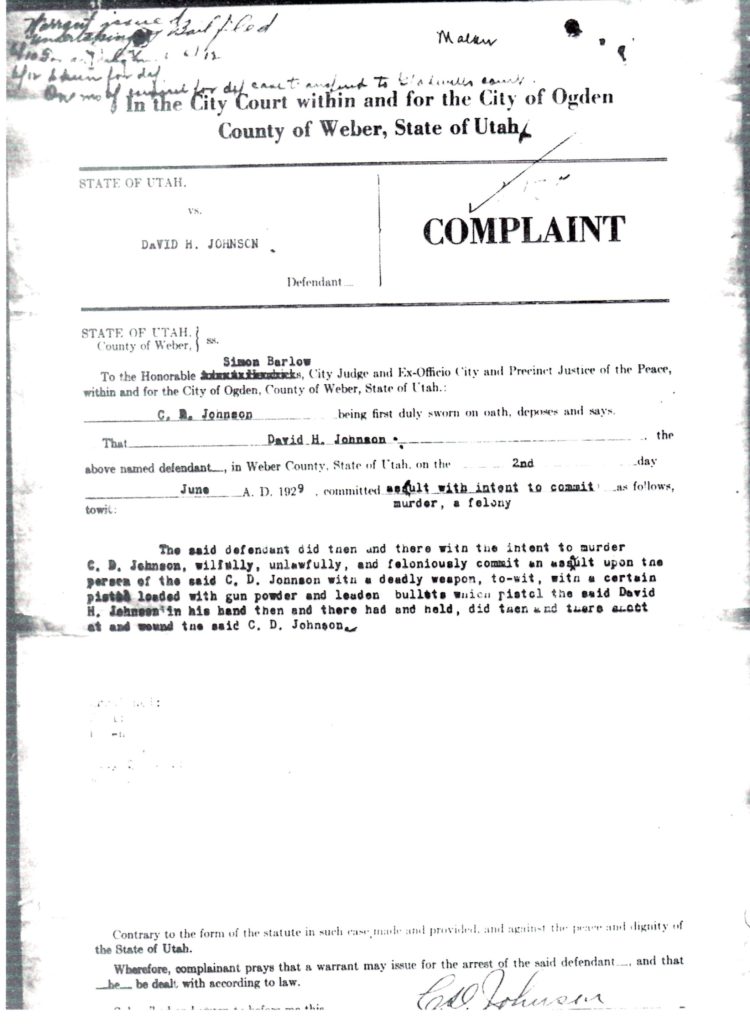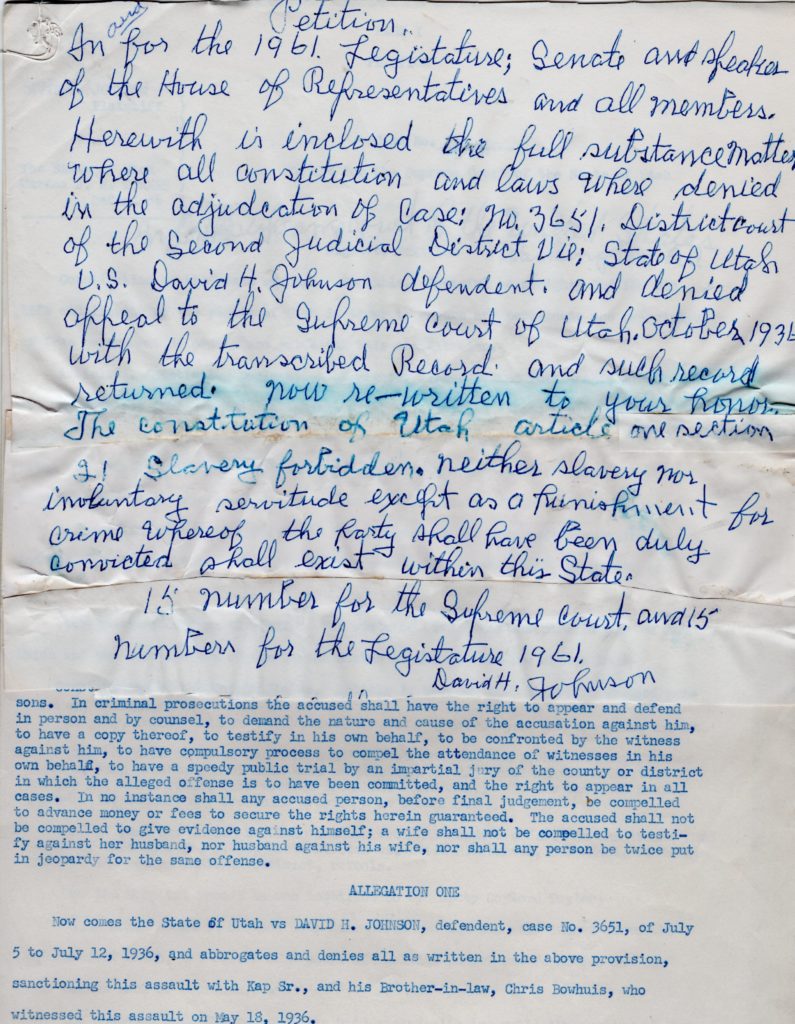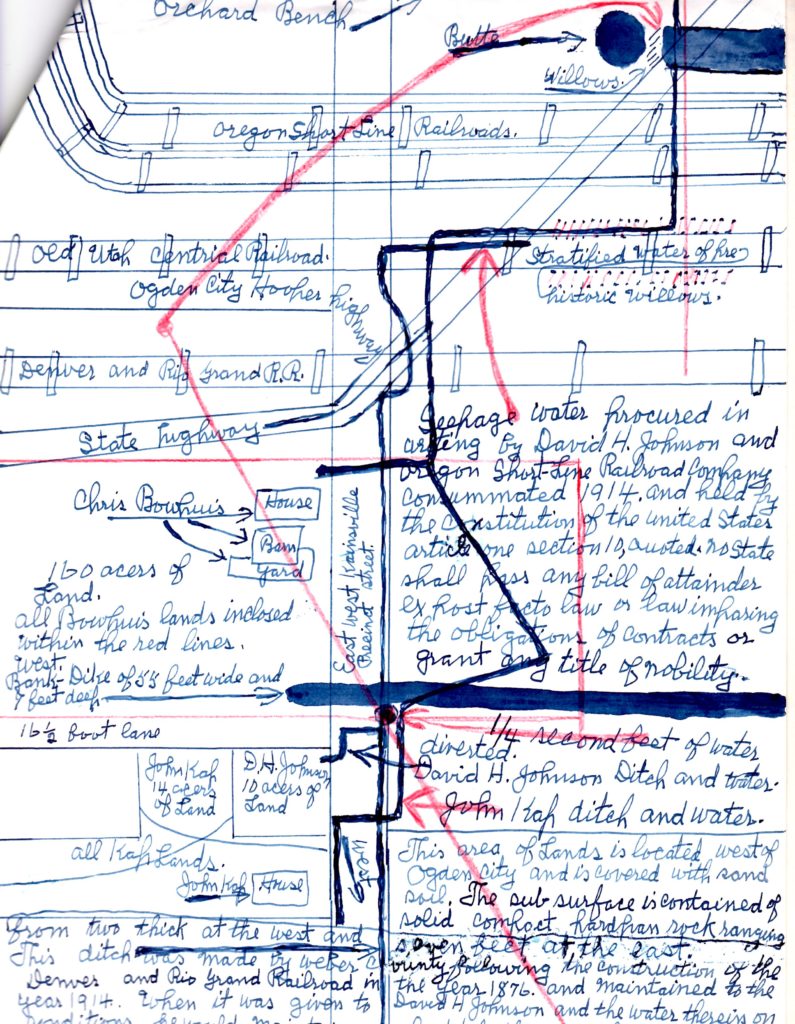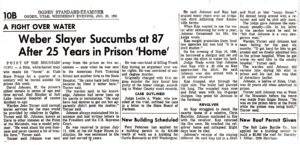Introduction and Disclaimer
I have been intrigued by the story of Uncle David Johnson since my father told it to me years ago. I always found it rather sad. I have done some digging in an attempt to get a better understanding of what really happened. Some families may be embarrassed by this kind of story and even refuse to discuss it. I find these kinds of things fascinating. They kind of bring out an inner detective in me.
With many such stories, there is the family version and a somewhat different version given through records. Some of the family version is what my father has remembered, being just a child when all these things happened.
I have poured though David’s numerous petitions, trying to make sense of them. They have the outward appearance of formal legal documents, but they are rambling, disjointed, repetitive, and confusing. The ones I have copies of are dated 1958-1960, so were written long after the incidents.
I searched legal records at the Utah State History office and found even more petitions among the court documents. Some of the newspaper articles I have read have obvious errors.
I of course, have my own biases and perspective based on my experiences. I will try to present what I have learned and what conclusions I have made, as well as what questions I still have.
The Family Story
The story my father told starts with David being a very successful farmer. The land west of Ogden was alkaline. David developed a drainage system which leeched the alkali from the soil. He raised very good crops there, much better than his neighbors, which raised suspicion and allegations that he was taking more than his share of water.
The picture in my mind as I heard Dad’s story was of a wild west shootout with David in a ditch shooting to defend himself. David was shot in the head. The other guy was shot too – but he died. David was convicted of murder and served a life sentence in the Utah State Penitentiary.
Through research I realized that this was just the final chapter of David’s story, which had many more interesting details.
Water Wars Part One
David Johnson homesteaded some land in Ogden Valley as a young man. He was married at age 25 in 1900, so may have already owned this land for a while before his marriage. He had a dispute there with some of the neighbors over water rights. He outlined this dispute in a document titled “Attachment to Brief on Appeal” apparently drafted as part of an appeal to this first conviction.
David owned 160 acres located at the mouth of Wolf Creek Canyon in Eden. The officers of the Eden Irrigation Canal Company at that time were George Fuller, Ben Colvin and Virgil Stallings. David apparently had two shares and an allotted time to water his land, but one week when there had been rain, he diverted “surplus” water to a narrow strip of land, where it would run into the canal.
David was accused of stealing the canal water, was found guilty by a Justice of the Peace and fined $1200.00. David appealed this decision to the District Court.
The details in David’s petition are rather confusing, but the sense I get is that he felt that the Canal trustees had resources and power and pressured him to abandon his land. He was rather young at this time, and according to my father, he agreed to sell rather than face legal consequences. David sold this land in February 1904 to Anthon F. Anderson.
Water Wars Part Two
After selling his land and leaving Eden in 1905, David lived in Ogden City for several years. He first lived on Jefferson Avenue and then later in West Ogden on E. Ave. He bought a farm in Kanesville, in Weber County in 1914.
On June 2, 1929 David had another dispute over a bill for pasturage. This one was with a neighbor named Carl D. Johnson (no relation). David fired three shots at this other Johnson, one going through his hat. Carl Johnson hit David and knocked him down with a shovel. David was charged with assault with a deadly weapon and intent to commit murder.

Complaint of assault with intent to commit murder 1929
The case was transferred to the Court of Justice of the Peace Gladwell in Burch Creek (now South Ogden).

Salt Lake Tribune 6-13-1929

Salt Lake Tribune 10-16-1929
Water Wars Part Three
Adjacent to David’s land in Kanesville was land owned by John Kap. David claimed he had been threatened by Kap and Kap’s brother-in-law Chris Bowhuis, “If you don’t leave this country at once and give us your land ditch and water in this street, we are going to kill you and bury you like a rat.” Apparently they had dug a “grave” already for him.
David asserted that the State of Utah had denied all right held by David H. Johnson of land ditch and water as stood in this street. This had been acquired by Weber County on the construction of Utah Central Railroad in 1876, and when the road grade was built, it dug up the Salt Lake Valley hard pan rock, and stopped the flow of such under ground water coursing west to the lake. The State of Utah engineer, George M. Bason accorded this to David H. Johnson by State filing No. 9727 April 1925. This was proved up on and recorded January 1928. David Johnson used this for 11 years to May 19, 1936.

Map drawn by David
The Shootout
May 19, 1936, John Kap went to this ditch which was adjacent to Johnson’s land, armed with a 22 rifle and shovel. David was working on his land as Kap passed. David described the incident:
“As I Johnson took up a 22 rifle loaded with a long bullet and walked to my ditch in this street a legal appurtenance to my land, and saw Kap and Bowhuis dug grave and threw all into the gutter east of the pile of dirt, crawled to the pile of dirt to see where old Kap was; he was standing with his 22 rifle resting, pointed at me and fired a 22 bullet into my head, and then Kap walked to me living to stiff to raise up, when I shot old Kap in the center breast bone in self defense.”
Apparently Chris Bowhuis called the Sheriff’s office and Deputy Gaylord Taylor arrested David and took him to the Dee Hospital. According to his own account, David had a
“small wound in the frontal hair line about two and one half inches above the superorbital notch; the bullet of a short 22 calibre bullet was found two and half inches back of entrance. The X-ray picture is on file at the hospital. J. Howard Jenkins (Hospital Principle). The morning of May 20, 1836 the hospital informed the county Physican, doctor Feller, who examined this head and reported death is imminent unless the foreign body is removed at once from this man head. The hospital X-rayed his head and Doctor Feller parted to scalp to show the bullet, then shaved the bullet down to the part he removed it.”
John Kap was apparently also taken to the hospital. His wounds were described in court transcripts:
“The X-ray picture reveals he was shot from the front of his body with a long 22 bullet that struck his center breast bone; and entivraly turned to the right, and lodged in his left lung. Juryman you see the metal specks shattered all over his cut open breast, from the bullet striking his breast bone.”
John Kap died May 27, 1936. Apparently he was recovering from his wound, but later died of a lung hemorrhage. David was then charged with murder.
The Trial
The main witnesses at the trial were the family members of the victim and the police officer. I question whether David had very good legal counsel. David fell asleep at his preliminary hearing, and reportedly got angry at the Judge at times during the trial. The Judge also indicated that David had given varying details at times and he did not believe some of his claims.

Ogden Standard 6-2-1936
The Story From the Judge
The letter that Judge Leslie Wade wrote to the Parole Board gives his summary of the charges and the trial with additional details. He explained the dispute about the water and a statement David made to the Watermaster that he would kill Kap if he attempted to take water from the ditch. At 6 pm on May 19, Kap went to the ditch armed with a shotgun and a shovel, and with his brother-in-law Chris Bowhuis on lookout for any trouble.
David was there with a 22 rifle and a .38 caliber revolver. The judge described the incident as David firing first at Kap and then Kap rose up after falling to the ground and fired a shot at David which hit him in the head. Apparently there were more shots fired as Kap walked away.
The Judge also gave some additional background on David, which shows his opinion of him. He stated:
“Mr. Johnson has a rather notorious past history. He lives by himself in a very poorly furnished and very poorly built house. He has several chicken-coops and stables, and a person traveling by his place on the road wouldn’t know which was the house and which was the stable and which was a chicken-coop. I am informed that he has been married, but that his wife died many years ago, and that since about 1915 he has lived alone out in the neighborhood of where he lived at the time of the shooting.”
The Judge did give some indication that all sides were partly at fault in the ongoing water dispute. County Water Commissioners attempted to arbitrate the matter and there was previous court action. Interestingly the Judge stated that he had been involved as David’s attorney in a previous case and later withdrew, which raises some questions about his impartiality in this case.
The Judge also reviewed the earlier 1929 case, disputes in 1931 and 1932 with Kap and Bowhuis, and other petty court actions.
The Judge’s Assessment of David
“He seems to be a man that has brooded over his troubles so long that he is absolutely unable to see anything from the standpoint of the other person. He seems to be of a very sutbborn disposition, and has worked himself up to a stage where he feels that he is going to have his way or he is going to kill some one. As long as he is in this frame of mind, I felt that he is a very dangerous man to the public, or the community in which he lives.”
The Verdict
The jury was given options of finding David guilty of First Degree Murder, Second Degree Murder or involuntary manslaughter. David was convicted of Second Degree Murder. He was sentenced to the Utah State Penitentiary for life, a sentence which the judge described as “the extreme penalty which the law allowed me to give him, to wit, imprisonment for the remainder of his natural life.”

Petitions
David filed numerous and very detailed petitions. Petitions were directed to the District Court, the Utah State Supreme Court, The United States Supreme Court, Congress, and leaders of the Church of Jesus Christ of Latter-day Saints. He even has some addressed “To Whom it may Concern” and “If you have a conscience, read this”. Some list David as petitioner vs. the State of Utah, but one has David H. Johnson, plaintiff vs. Warden Turner, the Prison Warden. (The one who said at the time of his death, that Dave was a model prisoner.)
David must have gained some knowledge of the judicial system, some through experience, and likely through study in prison. He knew enough to create petitions, which contain some legal terminology, but are rather confusing and difficult to follow. He didn’t seem to understand appropriate procedures well.
 One petition with handwritten cover page over mimeograph copy. In the top right hand corner the pages are fastened together with thread sewn though.
One petition with handwritten cover page over mimeograph copy. In the top right hand corner the pages are fastened together with thread sewn though.
In his petitions, David cited the Constitution and other laws to try to establish that he had acted in self defense. Part of defense in these petitions involved the allegation that his property had been illegally taken from him. Apparently Chris Bowhuis was allowed to possess David’s “land ditch and water, 6 cows two horses 500 chickens and 5000 value of chattel property and imprison Johnson for life.”
Some of the petitions included hand drawn maps.

Appeals and Parole Hearings
David’s case went before the Parole board a number of times and was denied each time. He was denied Parole in February 1940.

Ogden Standard-Examiner 3-17-1946
A self-prepared clemency appeal was denied by the Pardon board March 17, 1946. Mrs. Kap, the widow of John Kap appeared before the board and said that she would fear for her safety if David was released.
Dec 23, 1951, David made another appeal to the parole board, still saying he was innocent.
It is interesting that the Prison Warden, John Turner, is quoted in this article after David’s death, saying that he was a model prisoner and caused no trouble there, yet the Judge had indicated in his letter to the Parole Board that if David’s attitude changed, parole might be appropriate.
Warden Turner also said that to his knowledge David had never been up for parole or termination. “He may have had desires to get out but apparently didn’t push the matter”. I wonder how well this Warden actually knew David. It does appear that David spent the remainder of his life rather obsessed with trying to get out of prison.
The End of David’s Life and Struggle
David did spend the remainder of his life in prison. He actually was taken to Salt Lake General Hospital and died there, rather than in the prison itself.
 Ogden Standard-Examiner Jan 25, 1961
Ogden Standard-Examiner Jan 25, 1961
My Impressions
Are we seeing a pattern here? A single incident might lead one to believe that David had indeed been ganged up on, provoked and taken advantage of. But there seem to be repeated conflicts with neighbors which escalated to the point of violence. David clearly had trouble getting along with neighbors and had a hot temper.
I do believe that David felt that he was being threatened and needed to defend himself and his property. I think he truly felt he was the one being attacked and acted in self-defense.
In the first incident in Eden, David was very young and up against the established leaders of the community. In the last incident, the “victim” Kap and neighbor Bouwhuis were relatives and had other family members taking their side. David’s property was very literally surrounded by the land of these two.
But I have to wonder if some of this feeling like a victim of conspiracies was a bit of paranoia. The mention from the Prison Warden about David being sent to the State Mental Hospital and the institution in American Fork, may suggest that some thought that he suffered from some impairment or mental illness. Also there was mention of a potential insanity defense to the murder charge.
Having some experience with traumatic brain injuries, it would make some sense to me that after the last incident where David was shot in the head, he may have had some impairment because of that. That might account for some things, like not being able to communicate coherently his account and falling asleep in court during his preliminary hearing. Though feelings of persecution and violent responses were evident much earlier.
I still feel that Uncle David’s life was rather sad.
